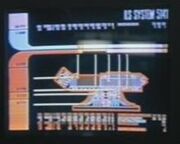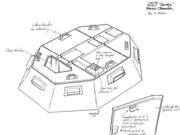m (Added links.) |
m (fm fx) |
||
| (32 intermediate revisions by 21 users not shown) | |||
| Line 1: | Line 1: | ||
| + | {{merge|cryogenic chamber{{bracket right}} and {{bracket left}}cryostasis chamber}} |
||
| − | A '''stasis pod''' is a container within which an object, [[animal]], or person is kept in [[stasis]] via a [[stasis field]] or [[cryogenics]]. The result is that [[time]] either stops or seems to stop for the object or [[lifeform]] in the stasis pod. |
||
| + | [[File:Stasis units, Resolutions.jpg|thumb|[[Kathryn Janeway]] and [[Chakotay]] in stasis units]] |
||
| + | [[File:Stasis pod internal components.jpg|thumb|Diagram showing internal components]] |
||
| + | A '''stasis chamber''' (also called a '''stasis unit''', '''stasis pod''', '''stasis tube''', or '''bio-pod''') was a coffin-shaped device used to preserve life in critically-injured or terminally-ill patients until their conditions could be stabilized in a fully-equipped medical facility. |
||
| + | The stasis unit suspended all [[cell (biology)|cellular]] activity and [[disease]] processes, keeping the patient from succumbing to their illness or injury for an indefinite period. The device was not meant for saving a dead patient. However, it could preserve brain activity for few hours at most. Time was required to get the ailing patient into the unit before they succumbed, presumably so that more time was available as they came out of [[stasis]] to effect proper treatment. ({{TOS|Space Seed}}; {{TNG|Reunion}}; {{film|12}}) |
||
| − | Stasis pods have been used to facilitate long-range travel, especially in [[pre-warp]] [[ship]]s, and to enable the sick or injured to survive while [[medicine|medical]] assistance is not immediately available. See also "[[stasis unit]]". ([[TOS]]: "[[Space Seed]]"; [[TNG]]: "[[Reunion]]") |
||
| − | {{pna-incomplete}} |
||
| + | Stasis units became standard equipment on [[Starfleet]] vessels, including the {{class|Galaxy}} and {{class|Defiant}} [[starship]]s. |
||
| ⚫ | |||
| + | |||
| + | The [[Rakhari]] [[Croden]] held his [[daughter]] [[Yareth]] in a stasis pod in a cavern on an [[asteroid]] in the [[Chamra Vortex]] to prevent her being killed by the Rakhari [[government]]. ({{DS9|Vortex}}) |
||
| + | |||
| + | The last of the [[Vaadwaur]] [[species]] placed themselves into underground stasis units, which they called '''bio-pods''', in the [[15th century]] to survive the destruction of their civilization. The pods malfunctioned, and so the Vaadwaur did not awaken until [[Seven of Nine]] activated the pods in [[2376]]. ({{VOY|Dragon's Teeth}}) |
||
| + | |||
| + | The subjects of a failed [[Cardassian]] experiment involving [[psychotropic drug]]s were left in stasis tubes aboard [[Empok Nor]] when the station was abandoned. The soldiers were accidentally reawakened when a salvage team from [[Deep Space 9]] arrived in [[2373]]. ({{DS9|Empok Nor}}) |
||
| + | |||
| + | When [[Kathryn Janeway]] and [[Chakotay]] were infected with an [[insect]]-transmitted [[virus]] on a [[planet]] in the [[Delta Quadrant]] in [[2372]], [[The Doctor]] kept them in stasis chambers while he searched for a cure. After he was unsuccessful, the chambers were sent down to the planet so that the infection would not spread to the rest of the crew. ({{VOY|Resolutions}}) |
||
| + | |||
| + | {{class|Danube}} vessels were equipped with stasis chambers. ({{DS9|Change of Heart}}) |
||
| + | |||
| + | In late [[2374]], the entire crew of ''Voyager'' entered stasis units for protection, while ''Voyager'' crossed a [[Mutara class]] [[nebula]] that emitted lethal levels of [[subnucleonic radiation]]. Only the Doctor and [[Seven of Nine]] remained awake to operate the ship. ({{VOY|One}}) |
||
| + | |||
| + | The crew of the {{USS|Equinox}} modified a stasis chamber into a [[multiphasic chamber]] in the [[2370s]] to first study, then exploit [[nucleogenic lifeform]]s. ({{VOY|Equinox}}) |
||
| + | |||
| + | [[Lyndsay Ballard]] reported that after her [[death]] in [[2374]], she woke up in a stasis chamber surrounded by [[Kobali|aliens]], who had told her they had reanimated her body. ({{VOY|Ashes to Ashes}}) |
||
| + | |||
| ⚫ | |||
*[[Cryogenic stasis]] |
*[[Cryogenic stasis]] |
||
*[[Sleeper ship]] |
*[[Sleeper ship]] |
||
| + | |||
| ⚫ | |||
| + | == Background == |
||
| + | [[File:Stasis chamber sketch.jpg|thumb|The sketch by Rick Sternbach.]] |
||
| + | The stasis chamber seen in the ''[[Star Trek: Deep Space Nine]]'' episode "Vortex" was designed by [[Rick Sternbach]] who drew the sketch. ([[DS9 Season 1 DVD]] special feature "Deep Space Nine Sketchbook") |
||
| + | |||
| + | == External link == |
||
| + | *{{wikipedia|Stasis (fiction)}} |
||
| + | |||
| + | [[de:Stasiskammer]] |
||
| ⚫ | |||
| + | [[Category:Technology]] |
||
Revision as of 05:28, 6 March 2014
You can discuss this suggestion on the talk page.

Kathryn Janeway and Chakotay in stasis units

Diagram showing internal components
A stasis chamber (also called a stasis unit, stasis pod, stasis tube, or bio-pod) was a coffin-shaped device used to preserve life in critically-injured or terminally-ill patients until their conditions could be stabilized in a fully-equipped medical facility.
The stasis unit suspended all cellular activity and disease processes, keeping the patient from succumbing to their illness or injury for an indefinite period. The device was not meant for saving a dead patient. However, it could preserve brain activity for few hours at most. Time was required to get the ailing patient into the unit before they succumbed, presumably so that more time was available as they came out of stasis to effect proper treatment. (TOS: "Space Seed"; TNG: "Reunion"; Star Trek Into Darkness)
Stasis units became standard equipment on Starfleet vessels, including the Galaxy-class and Defiant-class starships.
The Rakhari Croden held his daughter Yareth in a stasis pod in a cavern on an asteroid in the Chamra Vortex to prevent her being killed by the Rakhari government. (DS9: "Vortex")
The last of the Vaadwaur species placed themselves into underground stasis units, which they called bio-pods, in the 15th century to survive the destruction of their civilization. The pods malfunctioned, and so the Vaadwaur did not awaken until Seven of Nine activated the pods in 2376. (VOY: "Dragon's Teeth")
The subjects of a failed Cardassian experiment involving psychotropic drugs were left in stasis tubes aboard Empok Nor when the station was abandoned. The soldiers were accidentally reawakened when a salvage team from Deep Space 9 arrived in 2373. (DS9: "Empok Nor")
When Kathryn Janeway and Chakotay were infected with an insect-transmitted virus on a planet in the Delta Quadrant in 2372, The Doctor kept them in stasis chambers while he searched for a cure. After he was unsuccessful, the chambers were sent down to the planet so that the infection would not spread to the rest of the crew. (VOY: "Resolutions")
Danube-class vessels were equipped with stasis chambers. (DS9: "Change of Heart")
In late 2374, the entire crew of Voyager entered stasis units for protection, while Voyager crossed a Mutara class nebula that emitted lethal levels of subnucleonic radiation. Only the Doctor and Seven of Nine remained awake to operate the ship. (VOY: "One")
The crew of the USS Equinox modified a stasis chamber into a multiphasic chamber in the 2370s to first study, then exploit nucleogenic lifeforms. (VOY: "Equinox")
Lyndsay Ballard reported that after her death in 2374, she woke up in a stasis chamber surrounded by aliens, who had told her they had reanimated her body. (VOY: "Ashes to Ashes")
Related topics
Background

The sketch by Rick Sternbach.
The stasis chamber seen in the Star Trek: Deep Space Nine episode "Vortex" was designed by Rick Sternbach who drew the sketch. (DS9 Season 1 DVD special feature "Deep Space Nine Sketchbook")
